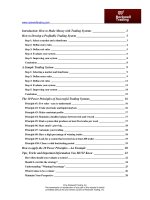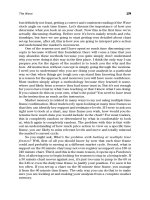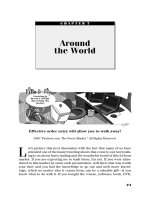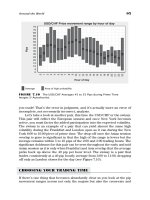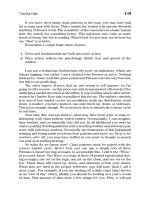How to make money trading the ichimoku system
Bạn đang xem bản rút gọn của tài liệu. Xem và tải ngay bản đầy đủ của tài liệu tại đây (28.22 MB, 310 trang )
About the Book
How to Make Money Trading Ichimoku Cloud Charts
Ichimoku Kinko Hyu, commonly referred to as Ichimoku indicator, is one of today’s most powerful
trading systems.
A Japanese innovation, like the candlesticks, it can be used with equal success to trade stocks,
commodities, futures, currencies and bonds — in fact, to anything that can be charted! Ichimoku also
works very well on all time frames, from the weekly all the way down to the one-minute chart.
Loosely translated, Ichimoku chart means a ‘one glance equilibrium’ chart. Due to the unique
construction of the Ichimoku cloud, which is the heart of this system, a trader can visually determine
in an instant whether a chart is bullish or bearish! Not just that:
Ichimoku clearly defines support and resistance, identifies trend direction, gauges momentum,
and provides trading signals.
It is the only system with a built-in forward looking indicator.
Looking at Ichimoku charts on multiple time frames can offer a tell-all x-ray into the dynamics of
any market.
It shows how to correctly time their entry and exit trades.
Most charting platforms today offer Ichimoku as an indicator.
Packed with in-depth analysis of high-probability trading strategies and numerous real-market
examples of stocks, derivatives, commodities and currency trades, this book reveals how you can
make money using the powerful Ichimoku system, the candlestick cloud charts.
About the Author
BALKRISHNA M. SADEKAR is the founder of Profitable Candlestick Charting LLC., an educational
company providing training to stock traders in the proper use of candlestick charting and technical
analysis. He is also a member of Technical Securities Analyst Association (TSAASF.org), a leading
authority for technical analysis in the United States.
With a Masters degree in Engineering, Sadekar has passionately blended technology with investor
psychology analysis via candlestick charts. A trader for more than a decade, he has trained and
continues training novice and experienced traders in correctly applying trading systems for profiting
from equity markets.
Sadekar resides in Richmond, VA in the US and can be reached via his website,
www.ProfitableCandlestickCharting.com. His first book, How to Make Money with Candlestick
Charts, also published by Vision Books, is a bestseller.
www.visionbooksindia.com
A Vision Books Original First eBook Edition, 2016
First Print Edition, 2016
eISBN
eISBN 10: 81-7094-970-X
eISBN 13: 978-81-7094-970-1
© Balkrishna M. Sadekar, 2016
First Published in 2016
by Vision Books Pvt. Ltd.
(Incorporating Orient Paperbacks & CARING imprints)
24 Feroze Gandhi Road, Lajpat Nagar 3
New Delhi 110024, India Phone: (+91-11) 2984 0821 / 22
email:
Contents
Acknowledgements
1. Introduction
The Important Numbers
Price Equilibrium
Ichimoku is a Trend Following System
Future Projection and Past Influence
2. Ichimoku Components
Tenkan
Kijun
Kumo
— Senkou A
— Senkou B
Chikou
3. Ichimoku Trading System
Tenkan / Kijun Cross Strategy (T/K Cross)
Kumo Breakout Strategy
Kijun Cross
Chikou Breakout
Kumo Twist
4. Kumo Break Strategy
Basic Strategy
Kumo Break Trading Strategy in Action
When the Kumo Break Strategy Fails
5. Tenkan / Kijun Cross Strategy
Basic Strategy
T/K Cross Trading Strategy in Action
6. How to Trade Any Asset in Any Market Using the Ichimoku
7. Ichimoku Trading Tips
Avoid Entering a Trade Before Earnings Announcements
Avoid Trading Low Volume Stocks
Timing Entries After Pullbacks in a Trend
Option Trading Strategies with the Ichimoku System
Trading in the Direction of the Bigger Trend
Take Partial Profits as They Accumulate
Position Sizing
8. Conclusion
What Type of Trading is Right for You?
Acknowledgements
I would like to thank my loving parents and in-laws for their support throughout my life. I am also
grateful for the wonderful support and love from my sister and her family.
I would like to thank folks at Chart Nexus for allowing me use of their stock charts. They have created
an excellent technical analysis charting platform with all the necessary tools needed for evaluating
stock charts.
I am thankful again to Vision Books India for believing in my efforts and publishing my second book
with them.
Lastly, a special thanks to the two amazing individuals in my life, my wife and daughter. They
continue to push me to achieve the best.
1
Introduction
Ichimoku Kinko Hyu, commonly referred to as Ichimoku, is one of the best systems available for
trading the markets. The Ichimoku indicator can be applied to stocks, commodities, futures, currencies
and bonds. If you can chart it, you can apply Ichimoku to it. It works very well on all time frames,
from the weekly all the way down to one minute chart. For those familiar with candlestick charts,
Ichimoku charts are a default extension of Japanese innovation.
Loosely translated, Ichimoku chart means a ‘one glance equilibrium’ chart. Once a trader is familiar
with the components of an Ichimoku system, it should take no more than a glance to decide if
the chart is bullish or bearish. This was the purpose with which Goichi Hosoda invented this
system. Goichi was a Japanese reporter who wanted to create an all-in-one indicator to visually
depict the market’s sentiment in the chart. After fine tuning it for many years, he finally published his
findings in Japan in the late 1960s. This was the first publication on Ichimoku system and it got
rapidly adopted by the Japanese traders and across Asia. Ichimoku started getting a following in the
Western world in the 1990s as computers became widespread. The computation involved in
developing and displaying the indicator got a lot easier with the help of computers. Most charting
platforms today offer Ichimoku as an indicator.
The Important Numbers
The Ichimoku system is based on three numbers: 9, 26 and 52.
There are a few theories about why these numbers were used by Goichi when he developed the
system.
In Japan, there were 26 trading days in a month in those days. So 52 days would account for two
months of trading activity. The number 9 was about a week-and-a-half of trading. Another theory
proposes that the number 26 was based on a lunar cycle. The fact is that it really does not matter. The
Ichimoku system works with amazing accuracy with these original numbers. Traders often try to
change and experiment with the number settings. There’s nothing wrong with that and you might want
to do so as well. Please make sure, however, that you are not curve-fitting the settings. You might find
some settings working flawlessly on a 5-minute chart, but when you try to use them on the daily chart,
they fail dramatically. So keep that in mind if you want to play with different numbers on your
Ichimoku chart. I would strongly suggest using the original numbers as they have stood the test of
time on all time frames and across all asset classes.
As mentioned earlier, Ichimoku charts are meant to show investor sentiment at a glance. Another huge
advantage of this system is that there is no need for other indicators and oscillators. One of the big
dilemmas traders face is what indicators or oscillators to use. Choosing between hundreds of them
and experimenting with their individual settings is a daunting task. Most times traders will use an
indicator for a few trades and if the trades don’t work, move on to the next indicator. This way, they
never really get to experience the indicator in all situations. They keep moving from indicator to
indicator and from one trading system to another, finally blowing out their account. There is no
indicator, oscillator or trading system out there which will work 100% of the time. So is Ichimoku the
holy grail for traders? Obviously not! The holy grail in trading is a myth. Each system has its flaws. It
is how a trader uses the system that makes the system profitable. Remember that the goal of trading is
to make more profits than losses. It is not to make only profitable trades. That is impossible. In fact,
research has shown that successful traders have a higher number of losing trades than winning ones.
They are successful because of one simple reason. The profits in their profitable trades are far higher
than the losses in their losing trades. Most inexperienced traders have exactly the opposite situation.
They go for quick profits, but let the losers run. This mindset needs to change! The Ichimoku system,
with its dynamic support / resistance components is well suited to help the trader in adhering to strict
rules.
Price Equilibrium
The core of the Ichimoku system is built around the relationship between price and its equilibrium. In
the Western world, equilibrium is based on closing prices of an asset. An example of this would be a
50- or 200-period simple moving average. Technical analysts will often refer to these as equilibrium
for price; namely, the price cannot stray too far from them and has to revert back sooner or later. In
the Japanese world, the high and low of the trading period is considered equally important as the
price open and close. The high is the point where demand was overwhelmed by supply. The low is
where buyers provided enough demand to absorb supply. These two price extremes give the range of
trading activity for that period. This range changes every period and is dynamic. If prices do not make
new highs and new lows within a certain amount of time, the equilibrium will be maintained and
price could gravitate towards it. In bullish trends, this equilibrium keeps moving higher as the price
achieves new highs. In bearish markets, on the other hand, the equilibrium moves lower as the lows
keep falling. These trends continue so long as the demand / supply relationship doesn’t revert. When
it does, price breaks out through the equilibrium and starts moving in the opposite direction.
In Ichimoku, equilibrium is calculated as the average of the highest high and the lowest low in three
different periods. Any guesses which three periods?
Yes, 9, 26 and 52!
Ichimoku is a Trend Following System
Most successful traders make their money trading trends. It is extremely difficult to derive profits
from a non-trending market. Ichimoku helps mitigate this issue to a certain extent. It helps the trader in
identifying non-trending markets, so that they can be avoided. As you will read in the next chapter,
the Ichimoku system has a built-in zone, called the Kumo cloud, which signifies consolidation.
Traders need to be extra cautious initiating trades when the price is within the Kumo, as it is then in a
non-trending phase.
The individual components of Ichimoku are designed to provide the following information:
Is the chart bullish or bearish?
Is the chart displaying consolidation of price?
If the chart is bullish, is there momentum in the trend?
If the chart is bearish, is there momentum in the trend?
If a chart is consolidating, how long would it be before the consolidation might get over?
Where is the price equilibrium? For bullish markets, this would be support; and for bearish
markets this would be resistance.
Future Projection and Past Influence
Another in-built feature of Ichimoku is the projection of future price action. Goichi firmly
believed that current price action has repercussions in the future. Demand and supply available in the
present will create support and resistance in the future. Based on this assumption, the Ichimoku
system is designed to project dynamic support and resistance values 26 periods ahead in time. No
other indicator has such a future predicting feature.
Just as the present affects the future, the past also influences the present. Accordingly, prices from 26
periods ago are given great importance in the Ichimoku system. As Chapter 2 describes, traders need
to be particularly aware of this phenomenon.
I would urge the reader to read and re-read Chapters 2 and 3 until the Ichimoku components and their
significance is clear and well understood. Chapters 4 and 5 constitute a practical guide to Ichimoku
trading.
Welcome to the world of Ichimoku! You will profit from it.
2
Ichimoku Components
The Ichimoku system has five components to it:
Tenkan;
Kijun;
Senkou A;
Senkou B; and
Chikou.
The Senkou A and Senkou B together form a structure commonly known as the Kumo cloud.
We will explain the five components in this chapter. Keep in mind that these components are highly
effective when used as a system. Chapter 3 will deal in detail about integrating the five components
together to form a trading system.
Tenkan
Tenkan, also known as ‘the Conversion Line,’ is calculated by averaging the highest high and the
lowest low of the previous 9 periods. Keep in mind that the Japanese place a lot of importance on
how the price behaves during the entire trading period. The high and the low of the day are as
important as the open and close of the candle on the candlestick chart. The high point of the candle is
where demand was overcome by supply and the low point of the candle is where supply was
absorbed by the demand. This is the crucial point of candlestick charts and is carried over in the
Ichimoku as well. In other words, the average of the high and low will give the equilibrium of
price for that period. So the average of highest high and lowest low of the last 9 periods will
provide an equilibrium point for price over the previous 9 periods.
Tenkan = (Highest high of 9 periods + Lowest low of 9 periods) ÷ 2
Please note that the Tenkan differs from the 9-period exponential moving average (EMA) and the 9period simple moving average (SMA). Both SMA and EMA are based on closing prices and are
much smoother than Tenkan. Tenkan, by its very nature, will exhibit periods of flattening as can be
seen in Figure 2.1.
Figure 2.1: Tenkan versus EMA and SMA; notice the flattening of Tenkan in the right hand part of the chart
If a stock jumps up and then starts moving sideways without making any new 9-period highs, then the
Tenkan will go flat thus visually indicating that price is consolidating. At that point, either the price
will come down to the Tenkan to find equilibrium or, after 9 periods, the Tenkan will start to rise to
support the price.
One can think of Tenkan as a short term “magnetic” guide for the price. Price cannot stray too
far from the equilibrium that Tenkan represents. For stocks in an uptrend, Tenkan acts as a
minor support level. On the other hand, for stocks in a downtrend, Tenkan provides minor
resistance.
You can see how Tenkan keeps providing support for the price in the chart of Axis Bank in Figure 2.2.
Price often times breaks the Tenkan intraday, but closes back above it indicating bulls coming in to
defend the equilibrium.
Figure 2.2: Tenkan provides minor support for the price in an uptrend
The five components of Ichimoku System — the Tenkan, Kijun, the Kumo made up of Senkou A and Senkou
B, and the Chikou
Correspondingly, chart of Bajaj Hindustan in Figure 2.3 shows the various times that Tenkan provided
resistance to any potential reversal in price.
Figure 2.3: Tenkan provides minor resistance to price in Bajaj Hindustan’s downtrend
Kijun
The Kijun, also called the ‘Base Line’ is primarily a trend container. It is calculated by averaging
the highest high and the lowest low of the previous 26 periods. Just like the Tenkan, the period can
mean a 1-minute, 5-minute or any other time frame. So the formula for Kijun is as follows:
Kijun = (Highest high of 26 periods + Lowest low of 26 periods) ÷ 2
Traders should not compare Kijun to a regular 26-period simple moving average or exponential
moving average. As the chart in Figure 2.4 shows, the Kijun is more sensitive to price highs and
lows and does not care about prices moving within the 26-period high / low areas. In the chart in
Figure 2.4, you would notice that while the 26-period SMA and EMA keep moving up, the Kijun goes
flat. The Kijun denotes equilibrium between the buyers and sellers. If prices over the last 26
periods are fluctuating in a range, the equilibrium will be at the mid-point of this range. This point
will attract prices back to it like a magnet. As Figure 2.4 shows, the EMA and SMA are lagging
indicators. Even though prices started going lower, these moving averages kept going higher. The
Kijun will be horizontal as soon as the stock stops making new highs and consolidates.
Figure 2.4: Kijun versus EMA and SMA; note how the Kijun is more sensitive to price highs and lows
If prices are above the Kijun, it is considered bullish.
If prices are below the Kijun, it is considered bearish.
Can the price move below the Kijun intra-time period? Sure it can. The key is that it should not close
decisively below it. As long as prices close above the Kijun, the stock is considered in an uptrend.
Once the price closes below it, the uptrend is considered broken. This does not mean a downtrend
has started. As you will see in the later chapters, all the Ichimoku components together alone tell the
whole story.
Notice how the Tata Power stock in Figure 2.5 occasionally dipped below the Kijun during the
uptrend until it finally broke down and closed below it.
Figure 2.5: Kijun provides major support to the price in an uptrend. Equally, it provides resistance to the price
in a downtrend
The Kijun provides strong support for the price in an uptrend. It also offers a strong resistance to the
price in a downtrend
Prices cannot get too far away from the Kijun. Again, keep in mind that the Kijun represents
equilibrium. Prices need to always be in sync with the equilibrium. That is where demand and supply
are balanced. Consider the chart in Figure 2.6 to understand how the Kijun acts as a magnet for
prices.
Figure 2.6: Kijun acting as a magnet for the price, attracting it back to itself time and again when it moves too
far away
After the downtrend, some event occurs to trigger exuberant buying in the stock. This can be seem in
the middle of the chart. This surge in demand leads to an exponential price increase in a short period
of time. Prices cannot keep rising that fast for too long, however. This leads to the Kijun initially
reacting to the price, from about 27 June till about 11 July, but then going flat as the stock could not
make new highs. The flat Kijun now starts attracting the price back to it.
Scenarios of exiting a trade when the price has considerably extended from Kijun, will often lead to
losses. They are best avoided for swing trading.
Figure 2.7 shows such a quick move to the upside. Anyone would want to take profits off the table if
presented with a 28% gain in a couple of weeks. Now, if enough traders decide to take profits, then
guess where the stock is heading? Down to its equilibrium!
Figure 2.7: A flat Kijun is a powerful magnet that pulls the price back towards itself
Ichimoku allows the trader to visually anticipate when the equilibrium is going to shift up or down.
Since we know that the Kijun is the average price of the highest high and lowest low of the previous
26 periods, one can notice from the chart if any of those two parameters are due for a change. Study
the chart of Axis Bank in Figure 2.8. Can you predict what Kijun will do the next day?
